Habitat Integrity in Protected Areas Threatened by LULC Changes and Fragmentation: A Case Study in Tehran Province, Iran
Abstract
1. Introduction
2. Materials and Methods
2.1. PAs of Tehran Province
- (1)
- Lar National Park has an area of about 28,037 ha on the western slopes of Mount Damavand between Mazandaran and Tehran Provinces. One hundred fifty-nine vertebrate animal species have been identified in this area, including Central Alborz Ovis orientalis (endemic species; IUCN red list category: endangered (EN)), Capra aegagrus (endemic species; IUCN red list category: vulnerable (VU)), Panthera pardussaxicolor (endemic species; IUCN red list category: critically endangered (CR)), and Canis lupus (endemic species; IUCN red list category: least concern (LC)). In addition, this area is considered as one of the few main habitats of Salmo trutta fario (endemic species; IUCN red list category: LC) in Iran and is therefore very important. In terms of vegetation, it has an alpine cover, medicinal plants, and food plants, which have a long history and good reputation [32,33].
- (2)
- Jajrud PA, with an area of about 75,670 ha, is located in the east of the Tehran metropolis. This area has the Khojir and Sorkheh Hesar National Parks, both of which have high biodiversity value. Jajrud PA is the primary habitat of O. orientalis and C. aegagrus species. Moreover, 517 vascular plant species have been identified in the area (e.g., Astragalus sp., Artemisia sp., Bromus sp., Amygdalus sp., and Zygophyllum sp.) [33,34].
- (3)
- TangehVashi is a national natural monument in Tehran Province with an area of 3650 ha and is located about 160 km from the metropolis of Tehran. This area is famous for its waterfall, beautiful plains, and historical relief. One of the prominent and endemic plant species of this area is Ferula gummosa, and among the wildlife species of this area are O. orientalis and C. aegagrus [35]. Figure 1 shows the location of the studied areas [36].
2.2. Methods
2.2.1. Research Methods
2.2.2. Classify Images
2.2.3. Landscape Metrics
2.2.4. Delphi Method
3. Results
3.1. LULC Temporal Change
3.2. Landscape Metrics Temporal Change
3.3. Assessment of Habitat Integrity
4. Discussion
5. Conclusions
Supplementary Materials
Author Contributions
Funding
Institutional Review Board Statement
Informed Consent Statement
Data Availability Statement
Conflicts of Interest
References
- United Nations. The Millennium Development Goals Report; United Nations Publications: New York, NY, USA, 2015. [Google Scholar]
- Evans, M. What Is Environmental Sustainability? Definition & Examples of Environmental Sustainability. Available online: https://www.thebalancesmb.com/what-is-sustainability-3157876 (accessed on 22 October 2021).
- Ervin, J.; Sekhran, N.; Gidda, S.; Vergeichik, M.; Mee, J. PAs for the 21st Century: Lessons from UNDP/GEF’s Portfolio; UNDP: New York, NY, USA, 2010. [Google Scholar]
- Sobhani, P.; Goshtasb, H.; Nezami, B.; Jahani, A. Evaluation of promoting conservation hunting areas: In the case Hamedan Alvand No-Hunting Area. J. Env. Sci. Tech. 2018, 20, 145–159. [Google Scholar]
- Leitao, A.B.; Ahren, J. Applying landscape ecological concepts and metrics in sustainable landscape planning. Landsc. Urb. Plan. 2002, 59, 65–93. [Google Scholar] [CrossRef]
- Haddad, N.M.; Brudvig, L.A.; Clobert, J.; Davies, K.F.; Gonzalez, A.; Holt, R.D.; Collins, C.D. Habitat fragmentation and its lasting impact on Earth’s ecosystems. Sci. Adv. 2015, 1, 1500052. [Google Scholar] [CrossRef] [PubMed]
- Venter, O.; Fuller, R.A.; Segan, D.B.; Carwardine, J.; Brooks, T.; Butchart, S.H.; Di-Marco, M.; Iwamura, T.; Joseph, L.; O’Grady, D.; et al. Targeting global protected area expansion for imperiled biodiversity. PLoS Biol. 2014, 12, 1–12. [Google Scholar] [CrossRef]
- Andreasen, J.; O’Neill, R.; Noss, R.; Sloser, N. Considerations for the development of a terrestrial index of ecological integrity. Ecolog. Indicat. 2001, 1, 21–35. [Google Scholar] [CrossRef]
- Fennell, D.A. A content analysis of ecotourism definitions. Curr. Issues Tourism 2001, 4, 403–421. [Google Scholar] [CrossRef]
- Department of the Environment of Iran. Reports of Iran’s Pas; Department of the Environment of Iran: Tehran, Iran, 2016.
- Department of Environment of Iran. Reports of Iran’s Pas; Department of Environment of Iran: Tehran, Iran, 2020.
- Uuemma, E.; Antrop, M.; Roosaare, J.; Marja, R.; Mander, U. Landscape metrics and indices: An overview of their use in landscape research’. Living Rev. Landsc. Res. 2009, 3, 5–28. [Google Scholar] [CrossRef]
- Paola, M.; Cafarelli, B.; Boccaccio, L.; Leronni, V.; Labadessa, R.; Kosmidou, V.; Nagendra, H. Using landscape structure to develop quantitative baselines for protected area monitoring. Ecolog. Indicat. 2013, 33, 82–95. [Google Scholar]
- Scariot, E.C.; Almeida, D.; Santos, J.E.D. Connectivity dynamics of araucaria forest and grassland surrounding Pass Fundo National Forest, southern Brazil. Nat. Conservação. 2015, 13, 54–59. [Google Scholar] [CrossRef][Green Version]
- Castillo, E.M.D.; Garcia-Martin, A.; Aladren, L.A.L.; Luis, M.D. Evaluation of forest cover change using remote sensing techniques and landscape metrics in Moncayo Natural Park (Spain). App. Geograp. 2015, 62, 247–255. [Google Scholar] [CrossRef]
- Bas-Kent, E.Z.; Kadıogulları, A.I. Spatial and temporal dynamics of land use pattern in Turkey: A case study in Inegol. Landscape Urban. Plan. 2007, 81, 316–327. [Google Scholar] [CrossRef]
- Çakır, G.; Sivrikaya, F.; Keles, S. Forest cover change and fragmentation using Landsat data in Maçka State Forest Enterprise in Turkey. Env. Mon. Assess. 2008, 137, 51–66. [Google Scholar] [CrossRef]
- Keles, S.; Sivrikaya, F.; Çakır, G.; Kose, S. Urbanization and forest cover change un regional directorate of Trabzon forestry from 1975 to 2000 using landsat data. Env. Mon. Assess. 2008, 140, 1–14. [Google Scholar] [CrossRef]
- Poças, I.; Cunha, M.; Pereira, L.S. Remote sensing-based indicators of changes in a mountain rural landscape of Northeast Portugal. App.Geograp. 2011, 31, 871–880. [Google Scholar] [CrossRef]
- Terzioglu, S.; Bas-kent, E.Z.; Kadıogulları, A.I. Monitoring forest structure at landscape level: A case study of Scots pine forest in NE Turkey. Env. Mon. Assess. 2009, 152, 71–81. [Google Scholar] [CrossRef]
- De Matos, T.P.V.; De Matos, V.P.V.; De Mello, K.; Valente, R.A. Protected areas and forest fragmentation: Sustainability index for prioritizing fragments for landscape restoration. Geol. Ecol. Landsc. 2019, 5, 19–31. [Google Scholar]
- Adriana-Chetan, M.; Dornik, A. 20 years of landscape dynamics within the world’s largest multinational network of protected areas. J. Env. Manag. 2020, 280, 111712. [Google Scholar]
- Botequilha-Leitao, A.; Miller, J.; Ahern, J.; McGarigal, K. Measuring Landscapes: A Planner’s Handbook; Island Press: Washington, DC, USA, 2006. [Google Scholar]
- Turner, M.G.; Gardner, R.H.; O’Neill, R.V. Landscape Ecology in Theory and Practice: Pattern and Process; Springer: New York, NY, USA, 2001. [Google Scholar]
- With, K.A. The theory of conservation biology. Conserv. Biol. 1997, 11, 1436–1440. [Google Scholar] [CrossRef]
- With, K.A. Landscape Connectivity and Metapopulation Dynamics; Gergel, S.E., Turner., M.G., Eds.; Springer: New York, NY, USA, 2002; pp. 208–227. [Google Scholar]
- Franklin, J.F.; Forman, R.T.T. Creating landscape patterns by forest cutting: Ecological consequences and principles. Landscape Ecol. 1987, 1, 5–18. [Google Scholar] [CrossRef]
- Zollner, P.A.; Lima, S.L. Landscape-level perceptual abilities in white-footed mice: Perceptual range and the detection of forested habitat. Oikos 1997, 80, 51–60. [Google Scholar] [CrossRef]
- Bolliger, J.; Wagner, H.H.; Turner, M.G. Identifying and Quantifying Landscape Patterns in Space and Time. In A Changing World; Landscape Series; Kienast, F., Wildi, O., Ghosh, S., Eds.; Springer: Dordecht, The Netherlands, 2007; Volume 8, pp. 177–194. [Google Scholar]
- Sadeghi, S.M.M.; Van Stan II, J.T.; Pypker, T.G.; Friesen, J. Canopy hydrometeorological dynamics across a chronosequence of a globally invasive species, Ailanthus altissima (Mill., tree of heaven). Agric. For. Meteorol. 2017, 240, 10–17. [Google Scholar] [CrossRef]
- Heshmatol Vaezin, S.M.; Moftakhar Juybari, M.; Daei, A.; Avatefi Hemmat, M.; Shirvany, A.; Tallis, M.J.; Hirabayashi, S.; Moeinaddini, M.; Hamidian, A.H.; Sadeghi, S.M.M.; et al. The effectiveness of urban trees in reducing airborne particulate matter by dry deposition in Tehran, Iran. Env. Mon. Assess. 2021, 193, 842. [Google Scholar] [CrossRef] [PubMed]
- Department of the Environment of Iran. Lar National Park Environmental Management Plan; Office of Habitats and Regional Affairs, First Consulting Engineers: Tehran, Iran, 2003.
- Department of the Environment of Iran. Jajrud Collection Management plan (Review) and Lar National Park Environmental Management Plan; Department of the Environment of Iran: Tehran, Iran, 2012. [Google Scholar]
- Department of the Environment of Iran. Jajroud Collection Management Plan; Office of Habitat and Regional Affairs, Boomabad Consulting Engineers: Tehran, Iran, 2001.
- Department of the Environment of Iran. TangehVashi National Natural Monument Management Plan; Office of Habitat and Regional Affairs, Department of the Environment of Tehran: Tehran, Iran, 2014.
- Department of Environment of Iran. Reports of Iran’s Pas; Department of Environment of Iran: Tehran, Iran, 2019.
- Taubenböck, H.; Esch, T.; Felbier, A.; Wiesner, M.; Roth, A.; Dech, S. Monitoring urbanization in mega cities from space Remote Sens. Environmental 2012, 117, 162–176. [Google Scholar]
- Patino, J.C.; Duque, J.C. A review of regional science applications of satellite remote sensing in urban settings. Comput. Env. Urb. Syst. 2013, 37, 1–17. [Google Scholar] [CrossRef]
- Chavez, P.S. Image-based atmospheric Corrections-Revisited and improved. Photogramm. Eng. Remote Sens. 1996, 62, 1025–1036. [Google Scholar]
- Anderson, J.R.; Hardy, E.E.; Roach, J.T.; Richard, E.W. A LULC classification system for use with remote sensor data. U.S. Geol. Survey Circ. 1976, 604, 1–27. [Google Scholar]
- Singh, S.K. Moderate deviation for maximum likelihood estimators from single server queues. Probab. Uncert. Quant. Risk 2020, 5, 1–13. [Google Scholar] [CrossRef]
- Ahmad, A.; Quegan, S. Analysis of maximum likelihood classification on multispectral data. Mathemat. Sci. 2012, 129, 6425–6436. [Google Scholar]
- Olofsson, P.; Foody, G.M.; Stehman, S.V.; Woodcock, C.E. Making better use of accuracy data in land change studies: Estimating accuracy and area and quantifying uncertainty using stratified estimation. Rem. Sens. Envi. 2013, 129, 122–131. [Google Scholar] [CrossRef]
- Lee, S.; Choi, J.; Min, K. Landslide susceptibility analysis and verification using the Bayesian probability model. Env. Geol. 2002, 43, 120–131. [Google Scholar] [CrossRef]
- Liu, J.; Dietz, T.; Stephen, R.; Carpenter, S.R.; Taylor, W.W. Complexity of coupled human and natural systems. Science 2007, 317, 1513–1516. [Google Scholar] [CrossRef]
- Congalton, R.G.; Green, K. Assessing the Accuracy of Remotely Sensed Data. Principles and Practices, 2nd ed.; CRC Press: Boca Raton, FL, USA, 2009; p. 384. [Google Scholar]
- Munthali, M.G.; Mustak, S.; Adeola, A.; Botai, J.; Singh, S.K.; Davis, N. Modelling land use and land cover dynamics of Dedza district of Malawi using hybrid Cellular Automata and Markov model. Remote Sens. App. Soc. Env. 2020, 17, 100276. [Google Scholar] [CrossRef]
- Sandhage-Hofmann, A. Rangeland Management. Reference Module in Earth Systems and Environmental Sciences; Elsevier: Amsterdam, The Netherlands, 2017. [Google Scholar] [CrossRef]
- Küchler, A.W.; Zonneveld, I.S. Vegetation Mapping; Kluwer Academic Publishers: Dordrecht, The Netherlands, 1988; p. 365. [Google Scholar]
- Zaitunah, A.; Samsuri, A.; Ahmad, A.G.; Safitri, R.A. Normalized difference vegetation index (NDVI) analysis for land cover types using Landsat 8 OLI in Besitang watershed, Indonesia. Earth Env. Sci. 2018, 126, 012112. [Google Scholar] [CrossRef]
- Jin, S.; Yang, L.; Zhu, Z.; Homer, C. A land cover change detection and classification protocol for updating Alaska NLCD 2001 to 2011. Remote Sens. Env. 2017, 195, 44–55. [Google Scholar] [CrossRef]
- Li, Z.; Shi, W.; Lu, P.; Yan, L.; Wang, Q.; Miao, Z. Landslide mapping from aerial photographs using change detection-based Markov random field. Remote Sens. Environment 2016, 187, 76–90. [Google Scholar]
- Noori, R.; Abdoli, M.A.; Ameri-Ghasrodashti, A.; Jalili-Ghazizadea, M. Prediction of municipal solid waste generation with combination of support vector machine and principal component analysis: A case study of Mashhad. Env. Progress Sustai. Energy. 2008, 28, 249–258. [Google Scholar] [CrossRef]
- Lua, P.; Qin, Y.; Li, Z.; Mondini, A.C.; Casagli, N. Landslide mapping from multi-sensor data through improved change detection-based Markov random field. Remote Sens. Env. 2019, 231, 111235. [Google Scholar] [CrossRef]
- Deljouei, A.; Abdi, E.; Marcantonio, M.; Majnounian, B.; Amici, V.; Sohrabi, H. The impact of forest roads on understory plant diversity in temperate hornbeam-beech forests of Northern Iran. Env. Monitor. Asses. 2017, 189, 1–15. [Google Scholar] [CrossRef] [PubMed]
- Deljouei, A.; Sadeghi, S.M.M.; Abdi, E.; Bernhardt-Römermann, M.; Pascoe, E.L.; Marcantonio, M. The impact of road disturbance on vegetation and soil properties in a beech stand, Hyrcanian forest. Eur. J. For. Res. 2018, 137, 759–770. [Google Scholar] [CrossRef]
- Lele, S.; Wilshusen, P.; Brockington, D.; Seidler, R.; Bawa, K. Beyond exclusion: Alternative approaches to biodiversity conservation in the developing tropics. Curr. Opin. Env. Sust. 2010, 2, 94–100. [Google Scholar] [CrossRef]
- Forman, R.T.T.; Lauren, E.A. Roads and their Major Ecological Effects. Annu. Rev. Ecol. Syst. 1998, 29, 207–231. [Google Scholar] [CrossRef]
- Haghverdi, F.; Jahani, A.; Zebardast, L.; Makhdom, M.; Goshtasb, H. Quantification of wildlife habitat disintegration using landscape ecology approach (case study: Lar National Park and Virgin PA). J. Animal Env. 2018, 10, 23–34. [Google Scholar]
- Torres-Morandi, D.; de Jesus-França, L.C.; Menezes, E.S.; Mendonça-Machado, E.L.; da Silva, M.D.; Mucida, D.P. Delimitation of ecological corridors between conservation units in the Brazilian Cerrado using a GIS and AHP approach. Ecol. Indic. 2020, 115, 106440. [Google Scholar]
- Chen, A.; Lei, Y.; Sun, R.; Chen, L.D. How many metrics are required to identify the effects of the landscape pattern on land surface temperature? Ecol. Indic. 2014, 45, 424–433. [Google Scholar] [CrossRef]
- Sadegh-Oghli, R.; Jahani., A.; Alizadeh Shabani., A.; Goshtasb., H. Quantifying the landscape fragmentation as an indicator for assessing wildlife habitat (Case Study: Jajroud PA). Land Use Plan. 2019, 11, 57–78. [Google Scholar]
- Jaeger, J.A.G.; Bertiller, R.; Schwick, C.; Muller, K.; Steinmeier, C.; Ewald, K.C.; Ghazoul, J. Implementing landscape fragmentation as an indicator in the swiss monitoring system of sustainable development. Env. Manag. 2008, 88, 737–751. [Google Scholar] [CrossRef]
- McGarigal, K.; Marks, B.J. FRAGSTATS: Spatial Pattern Analysis Program for Quantifying Landscape Structure. Forest Science Department. General Technical Report; USDA: Portland, OR, USA, 1995; p. 122. [Google Scholar]
- Kennedy, H. Enhancing Delphi research: Methods and results. J. Adv. Nursing. 2004, 45, 504–511. [Google Scholar] [CrossRef]
- Dunham, R.B. The Delphi Technique. Available online: http://www.slais.ubc.ca/resources/researchmethods/group.htm (accessed on 17 September 2021).
- Stern, T.; Ledl, C.; Schwarzbauer, P.; Heil, G. Identifying innovation barriers using a Delphi method approach: The case of technical lignin in the wood-based panel industry. Int. Wood Prod. J. 2012, 3, 116–123. [Google Scholar] [CrossRef]
- Sutterlüty, A.; Hesser, F.; Schwarzbauer, P.; Schuster, K.C.; Windsperger, A.; Stern, T. A Delphi approach to understanding varying expert viewpoints in sustainability communication: The case of water footprints of bio-based fiber resources. J. Ind. Ecol. 2016, 21, 412–422. [Google Scholar] [CrossRef]
- Huber, D.J.; Huber, J.; Hersser, F.; Hollbacher, E.; Stern, T. Two experts, three opinions: Volatile organic compounds’ testing methods and regulative systems. Eur. J. Wood Prod. 2018, 76, 5–12. [Google Scholar] [CrossRef]
- Dooms, M.; van der Lugt, V.; De Schepper, O. Socioeconomic Performance Assessment of Port Clusters: More Challenges, Fewer Solutions? Green Ports, Inland and Seaside Sustainable Transportation Strategies; Elsevier: Amsterdam, The Netherlands, 2019; pp. 231–253. [Google Scholar]
- Skokanova, H.; Eremlasova, R. Landscape functionality in protected and un PAs: Case studies from the Czech Republic. Ecol. Informatics 2013, 14, 71–74. [Google Scholar] [CrossRef]
- Majnonian, H. National Parks Planning (Park Management, Planning of National Parks and PAs); A Manual with Annotated Examples; Publications of Day Negar: Tehran, Iran, 2015; p. 308. [Google Scholar]
- Zhao, H.; Zhao, X.; Zhou, R.; Zhang, T.; Drake, S. Desertification processes due to heavy grazing in sandy rangeland, Inner Mongolia. J. Arid Environ. 2005, 62, 309–319. [Google Scholar] [CrossRef]
- Zhang, Q. The dilemma of conserving rangeland by means of development: Exploring ecological resettlement in a pastoral township of Inner Mongolia. Nomadic Peoples 2012, 16, 88–115. [Google Scholar] [CrossRef]
- Assaeed, A.M.; Al-Rowaily, S.L.; El-Bana, M.I.; Abood, A.A.; Dar, B.A.; Hegazy, A.K. Impact of off-road vehicles on soil and vegetation in a desert rangeland in Saudi Arabia. Saudi J. Biolog. Sci. 2019, 26, 1187–1193. [Google Scholar] [CrossRef] [PubMed]
- Jahani, A.; Saffariha, M. Human activities impact prediction in vegetation diversity of Lar National Park in Iran using artificial neural network model. Integ. Env. Assess. Manag. 2020, 17, 42–52. [Google Scholar] [CrossRef]
- Murray, D.B.; Muir, J.P.; Miller, M.S.; Erxleben, D.R.; Mote, K.D. Effective management practices for increasing native plant diversity on Mesquite Savanna-Texas Wintergrass-dominated rangelands. Rangel. Ecol. Manag. 2012, 75, 161–169. [Google Scholar] [CrossRef]
- Nacoulma, B.M.I.; Schumann, K.; Traore, S.; Bernhardt-Römermann, M.; Hahn, K.; Wittig, R.; Thiombiano, A. Impacts of land-use on West African savanna vegetation: A comparison between protected and communal area in Burkina Faso. Biodiv. Conserv. 2011, 20, 3341–3362. [Google Scholar] [CrossRef]
- Zhang, J.T.; Xiang, C.L.; Li, M. Effects of tourism and topography on vegetation diversity in the subalpine meadows of the Dongling Mountains of Beijing, China. Env. Manag. 2012, 49, 403–411. [Google Scholar] [CrossRef]
- Wei, L.; Hulin, F.; Chevalier, R.; Archaux, F.; Gosseli, F. Is plant diversity on tractor trails more influenced by disturbance than by soil characteristics? For. Ecol. Manag. 2016, 379, 173–184. [Google Scholar] [CrossRef]
- Deljouei, A.; Abdi, E.; Majnounian, B. Changes of trees regeneration diversity in main and secondary roads of Hyrcanian forests, Iran. J. Ins. Nat. App. Sci. 2014, 19, 30–35. [Google Scholar]
- De la Rosa-Velázquez, M.I.; Espinoza-Tenorio, A.; Díaz-Perera, M.Á.; Ortega-Argueta, A.; Ramos-Reyes, R.; Espejel, I. Development stressors are stronger than protected area management: A case of the Pantanos de Centla Biosphere Reserve, Mexico. Land Use Policy 2017, 67, 340–351. [Google Scholar] [CrossRef]
- Jiang, L.; Yu, L. Analyzing land use intensity changes within and outside protected areas using ESA CCI-LC datasets. Glob. Ecol. Conserv. 2019, 20, e00789. [Google Scholar] [CrossRef]
- Ghazvini, S.A.M.; Timothy, D.J.; Sarmento, J. Environmental concerns and attitudes of tourists towards national park uses and services. J. Outdoor Recreat. Tourism 2020, 31, 100296. [Google Scholar] [CrossRef]
- Xu, J.; Melick, D.R. Rethinking the effectiveness of public protected areas in southwestern China. Conserv. Biol. 2007, 21, 318–328. [Google Scholar] [CrossRef] [PubMed]
- Tehran Urban Research and Planning Center. East Tehran tourism pole studies report. In The Case SorkhehHesar Forest Park; Department of Environment: Tehran, Iran, 2014. [Google Scholar]
- Danehkar, A.; Jafari, S. Degradation assessment of Jajrud PA using landscape degradation model. Remote Sensing GIS Natur. Resour. 2017, 8, 17–32. [Google Scholar]
- Paziresh, R.; Sarvar, P.; Heidari-Baba-Kamal, Y.; Parhizi-Rad, A. Environmental impact assessment of rural tourism in TangehVashi using the DPSIR model. In Proceedings of the First National Conference on Tourism, Tehran, Iran, 2013; pp. 1–12. [Google Scholar]
- Esmaeilzadeh, H.; Ehteshami, M. Land use changes and restraining environmental risks via mitigation approach, the case of Darakeh -Velenjak watershed in Iran. Sustain. Earth Review. 2020, 1, 23–37. [Google Scholar] [CrossRef]
- Montoya, A.V.G.; Vizuete, D.D.C.; Toaza, J.M.M.; Marcu, M.V.; Borz, S.A. Importance and use of ecosystem services provided by the Amazonian landscapes in Ecuador-evaluation and spatial scaling of a representative area. Bull. Transilv. Uni. Bras. For. Wood Indus. Agric. Food Eng. Ser. II. 2019, 12, 1–26. [Google Scholar]
- Buckley, R.C. Environmental Impacts of Ecotourism; CABI Publishing: New York, NY, USA, 2004. [Google Scholar]
- Leung, Y.; Marion, J.L. Recreation Impacts and Management in Wilderness: A State of-Knowledge Review; Proceedings US Department of Agriculture, Forestry Service, Rocky Mountain Research Station: Missoula, MT, USA, 2000.
- Bruner, A.G.; Gullison, R.E.; Rice, R.E.; Da Fonseca, G.A. Effectiveness of parks in protecting tropical biodiversity. Science 2001, 291, 125–128. [Google Scholar] [CrossRef] [PubMed]
- Dai, L.; Wang, Y.; Lewis, B.J.; Xu, D.; Zhou, L.; Gu, X.; Jiang, L. The trend of land-use sustainability around the Changbai Mountain Biosphere Reserve in northeastern China: 1977–2007. Int. J. Sustain. Develop. World Ecol. 2012, 19, 369–377. [Google Scholar] [CrossRef]
- Ewers, R.M.; Didham, R.K. Confounding factors in the detection of species responses of habitat fragmentation. Biol. Rev. Camb. Philos. Soc. 2006, 81, 117–142. [Google Scholar] [CrossRef] [PubMed]
- Magrach, A.; Larrinaga, A.R.; Santamara, L. Changes in patch features may exacerbate or compensate for the effect of habitat loss on forest bird populations. PLoS ONE 2011, 6, 1–11. [Google Scholar] [CrossRef] [PubMed]
- Jaafari, S.; Alizadeh-Shabani, A.; Danehkar, A.; Nazarisamani, A.; Plexida, S. Application of landscape metrics for assessment of land use/ land cover (LULC) changes in Varjin protected area, Iran. Env. Eng. Manag. 2017, 12, 2813–2821. [Google Scholar] [CrossRef]
- Khedrigharibvand, H.; Azadi, H.; Teklemariam, D.; Ebrahimi, A.; Omidzadeh-Ardali, E.; Van Acker, V.; Van Eetvelde, V.; De Maeyer, P.; Witlox, F. Sustainable rangeland management in southwest Iran: Understanding changes in experts’ attitudes toward livelihood alternatives. Rangel. Ecol. Manag. 2019, 72, 433–445. [Google Scholar] [CrossRef]
- Chen, L.; Fu, B.; Zhao, W. Source-sink landscape theory and its ecological significance. Front. Biol. China 2008, 3, 131–136. [Google Scholar] [CrossRef]
- Wu, J.; Zhu, Q.; Qiao, N.; Wang, Z.; Sha, W.; Luo, K.; Feng, Z. Ecological risk assessment of coal mine area based on “source-sink” landscape theory–A case study of Pingshuo mining area. J. Cleaner Product. 2021, 295, 126371. [Google Scholar] [CrossRef]
- Draheim, H.M.; Moore, J.A.; Etter, D.; Winterstein, S.R.; Scribner, K.T. Detecting black bear source–sink dynamics using individual-based genetic graphs. Proceed. Royal Soc. B. Biol. Sci. 2016, 283, 20161002. [Google Scholar] [CrossRef] [PubMed]
- Bennett, A.F. Linkages in the Landscape. The Role of Corridors and Connectivity in Wildlife Conservation, 2nd ed.; IUCN, The World Conservation Union: Gland, Switzerland; Cambridge, UK, 2003; p. 262. [Google Scholar]
- Crooks, K.R. Relative sensitivities of mammalian carnivores to habitat fragmentation. J. Conserv. Biodiv. 2002, 16, 488–502. [Google Scholar] [CrossRef]
- Sobhani, P.; Esmaeilzadeh, H.; Mostafavi, H. Simulation and impact assessment of future land use and land cover changes in two protected areas in Tehran, Iran. Sust. Cities Soc. 2021, 75, 1–11. [Google Scholar] [CrossRef]
- Ritchie, B.W.; Burns, P.M.; Palmer, C.A. Tourism Research Methods: Integrating Theory with Practice; CABI: Cambridge, MA, USA, 2005. [Google Scholar]
- Roudgarmi, P.; Mahdiraji, M.T.A. Current challenges of laws for preservation of forest and rangeland, Iran. Land Use Policy 2020, 99, 105002. [Google Scholar] [CrossRef]
- Geldmann, J.; Barnes, M.; Coad, L.; Craigie, I.D.; Hockings, M.; Burgess, N.D. Effectiveness of terrestrial protected areas in reducing habitat loss and population declines. Biolog. Conserv. 2013, 161, 230–238. [Google Scholar] [CrossRef]
- Leberger, R.; Rosa, I.M.; Guerra, C.A.; Wolf, F.; Pereira, H.M. Global patterns of forest loss across IUCN categories of protected areas. Biolog. Conserv. 2020, 241, 108299. [Google Scholar] [CrossRef]
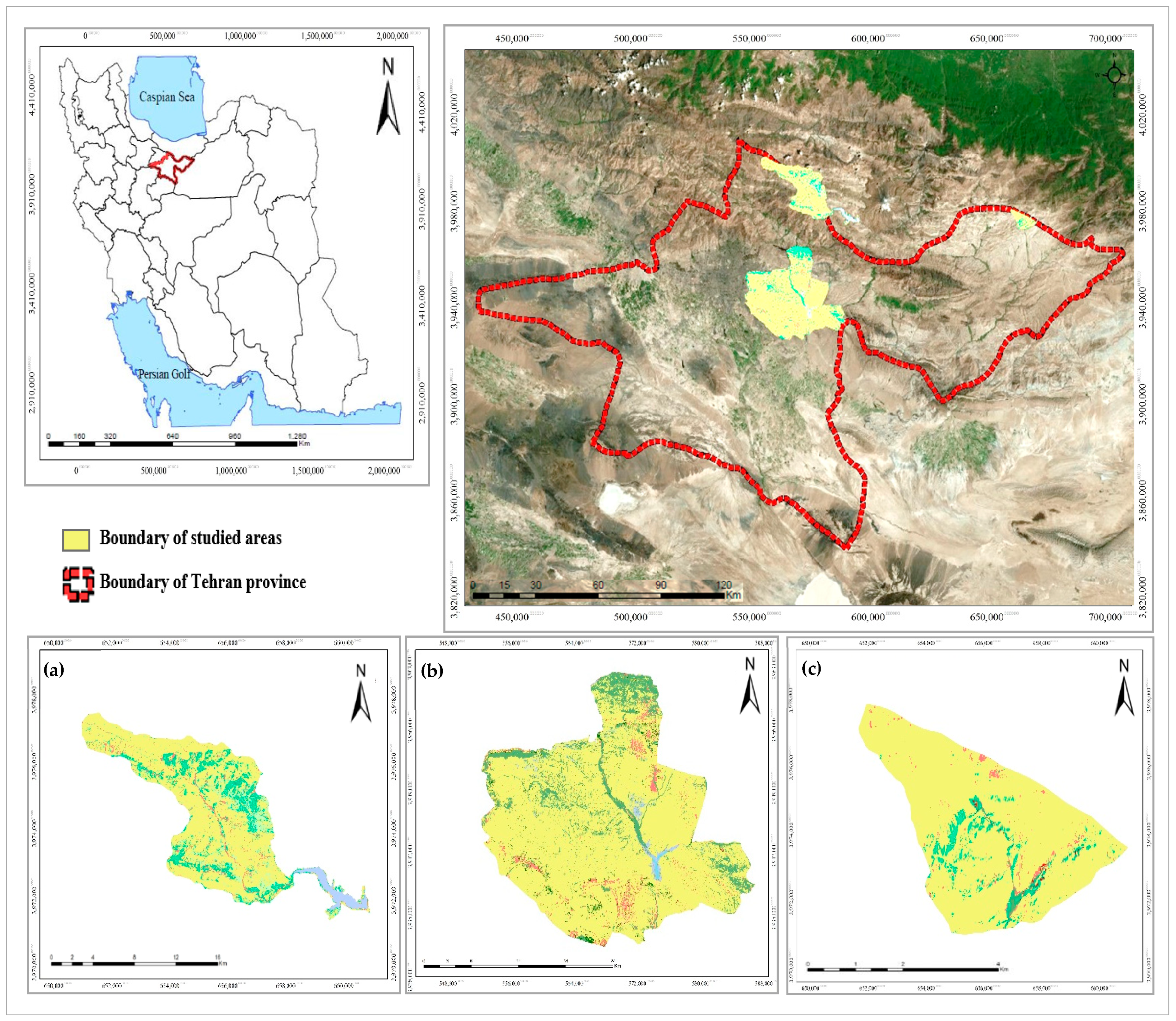
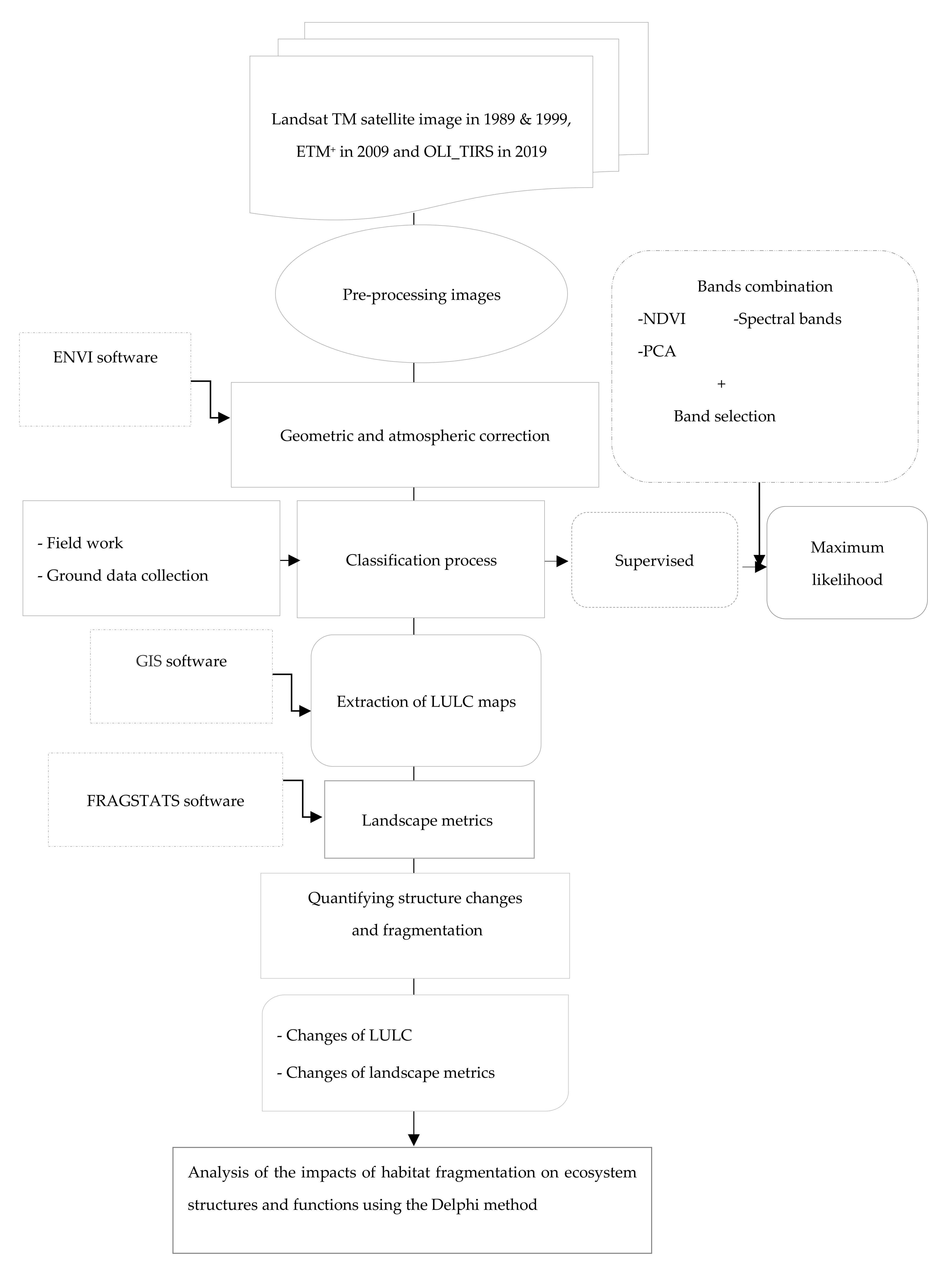
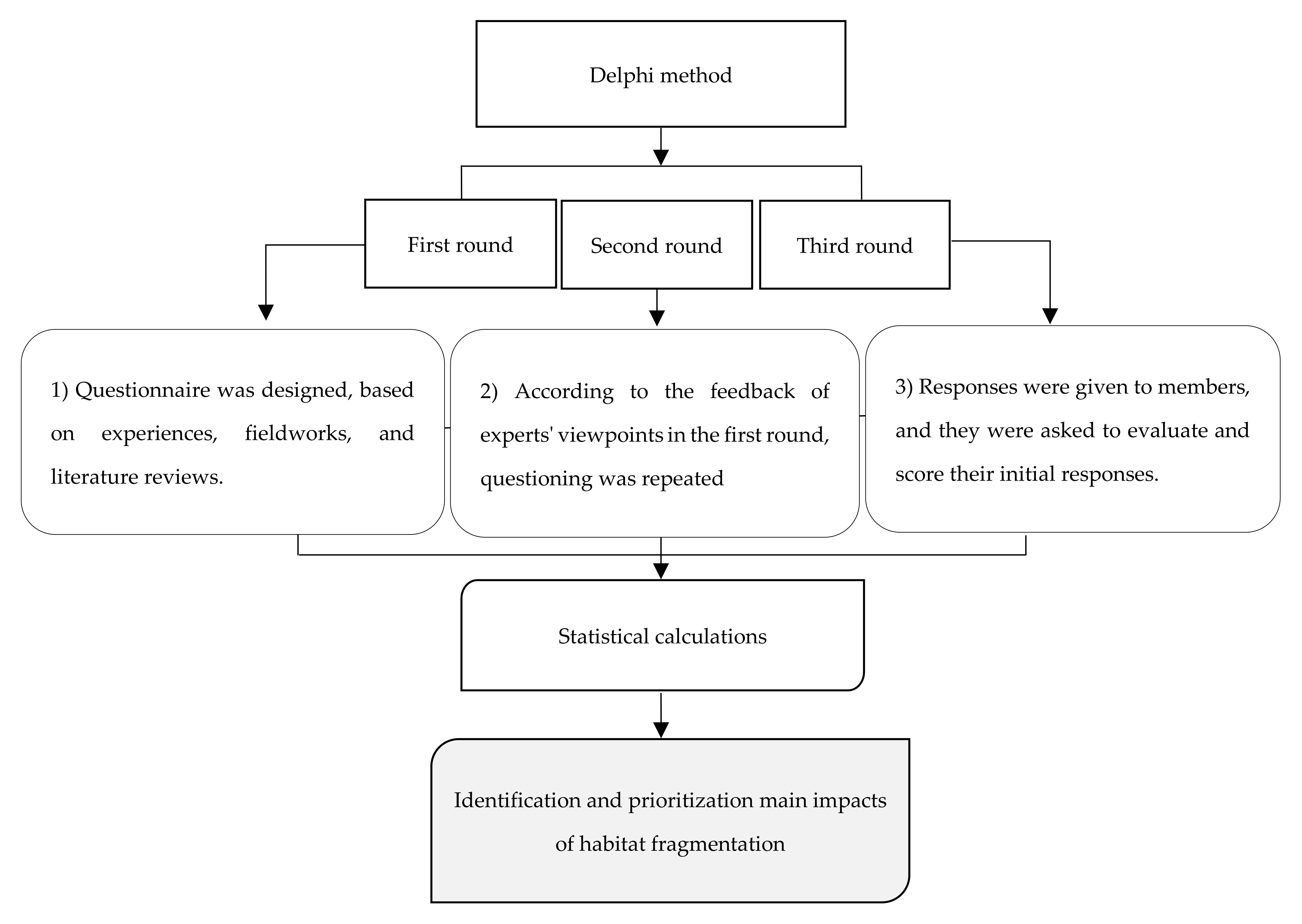
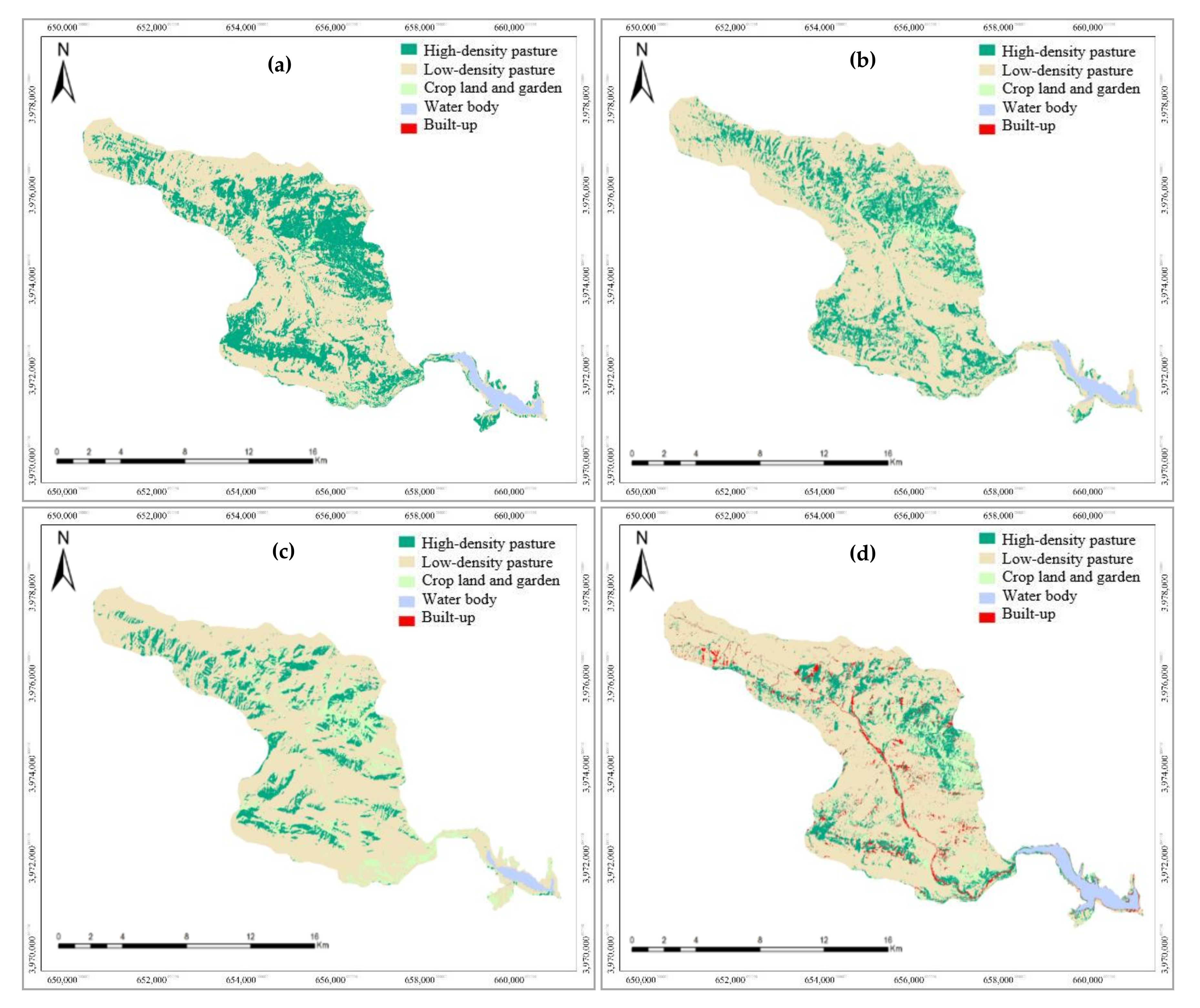
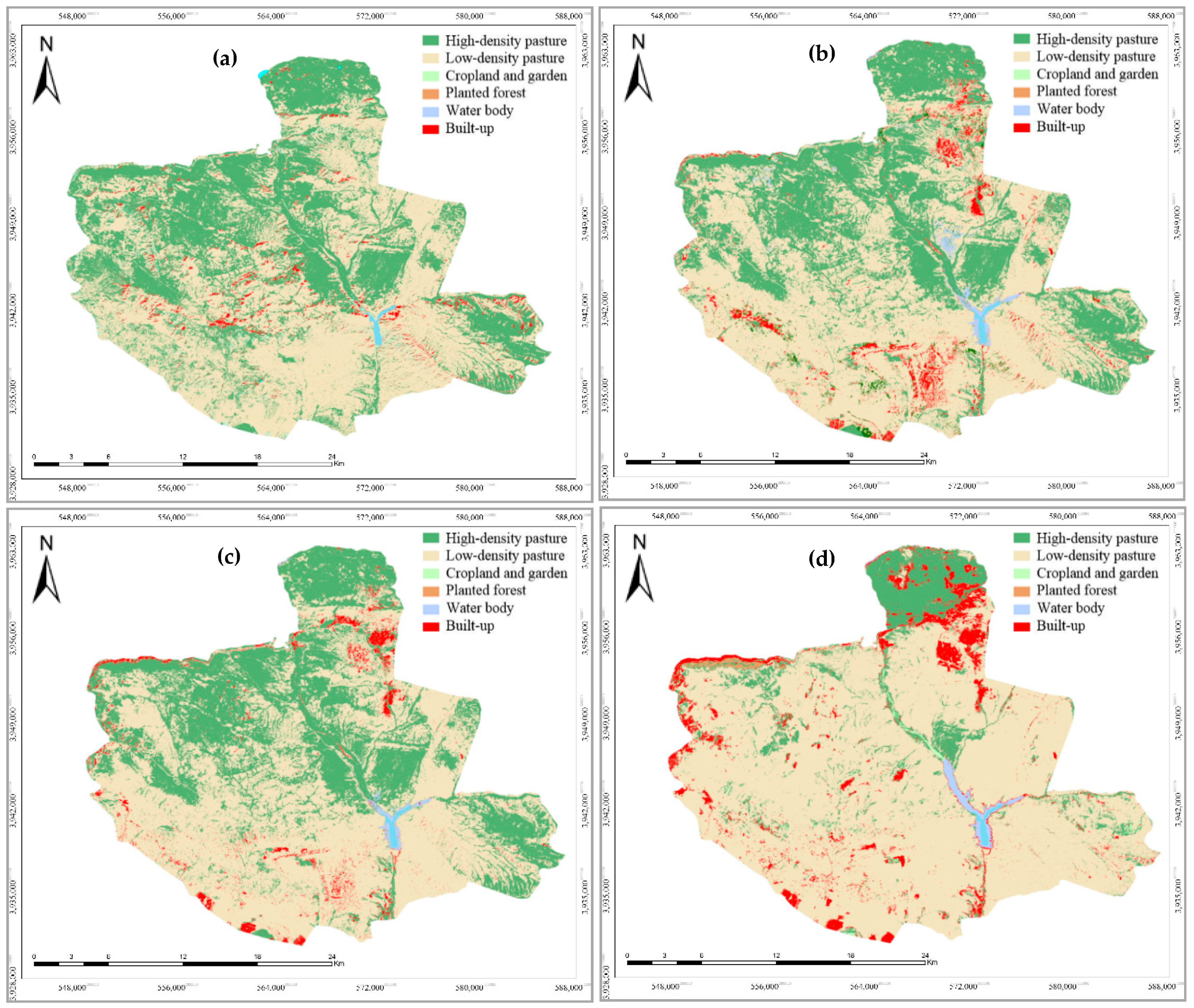
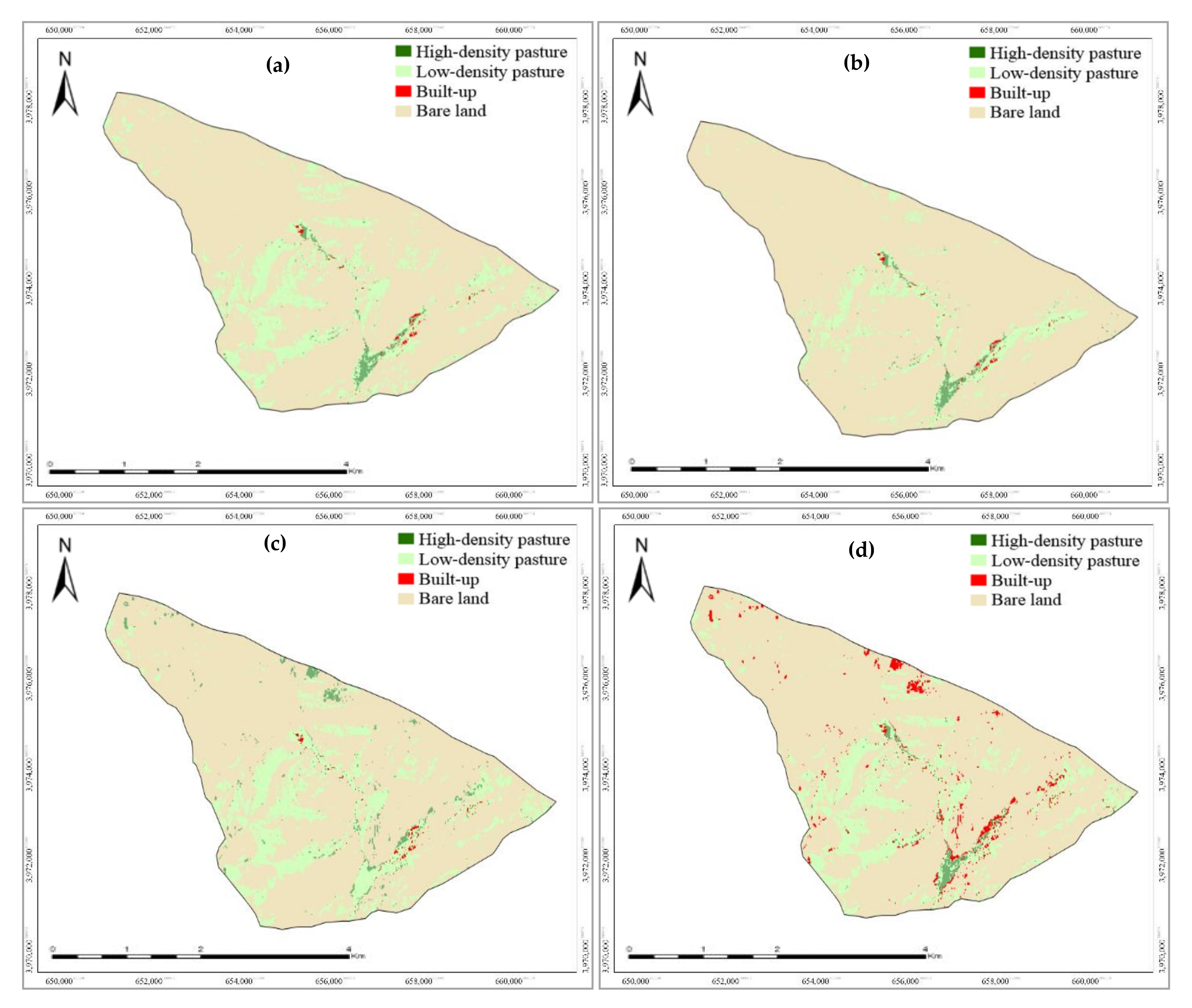
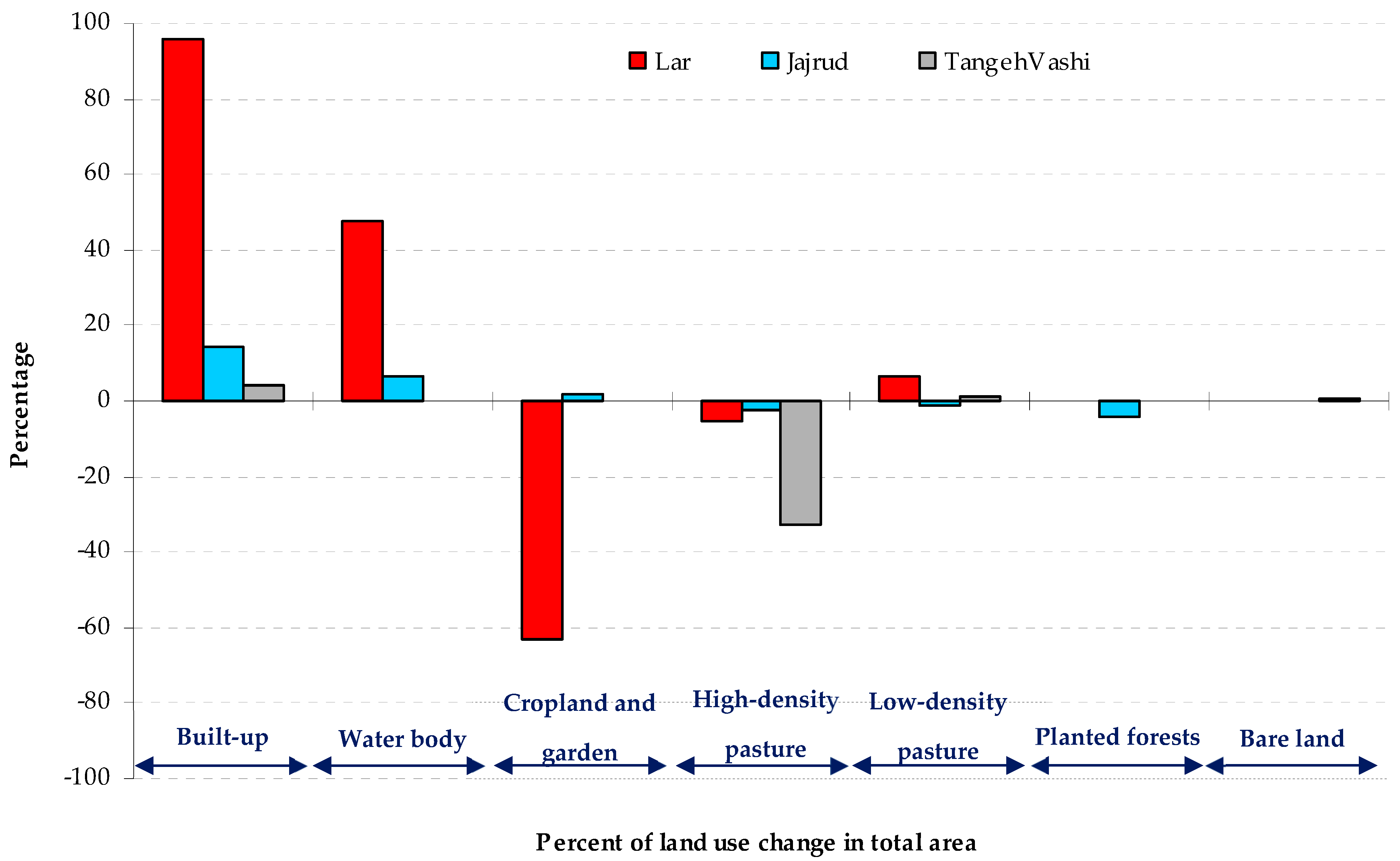
| Metrics | Range of Change | Calculation | Unit |
|---|---|---|---|
| Class Area (CA) | CA > 0 | ha | |
| Class Area Percentage (CAP) | 0 < CAP ≤ 100 | % | |
| Number of Patches (NP) | NP ≥ 1 | - | |
| Total Edge (TE) | TE ≥ 0 | m | |
| Mean Shape Index (MSP) | MSI ≥ 1 | - | |
| Mean Nearest Neighbor Distance (MNN) | MNN > 0 | m | |
| Mean Patch Size (MPS) | MPS > 0 | ha |
| Category | Science Field | Round 1 | Round 2 | Round 3 |
|---|---|---|---|---|
| Academics | Environmental engineering | 8 | 7 | 6 |
| Biodiversity | 10 | 8 | 8 | |
| Zoology | 7 | 6 | 5 | |
| Biology | 4 | 4 | 4 | |
| Landscape designing and planning | 6 | 6 | 6 | |
| Geography | 5 | 5 | 5 | |
| Total (number) | 40 | 36 | 34 | |
| Study Site | Year | Prepared Land Use Map | |
|---|---|---|---|
| Overall Accuracy (Unitless) | Kappa Coefficient (Unitless) | ||
| Lar National Park | 1989 | 0.9 | 0.86 |
| 1999 | 0.85 | 0.77 | |
| 2009 | 0.94 | 0.92 | |
| 2019 | 0.92 | 0.89 | |
| Jajrud PA | 1989 | 0.87 | 0.76 |
| 1999 | 0.92 | 0.88 | |
| 2009 | 0.85 | 0.81 | |
| 2019 | 0.97 | 0.95 | |
| TangehVashi Natural Monument | 1989 | 0.9 | 0.86 |
| 1999 | 0.87 | 0.83 | |
| 2009 | 0.91 | 0.85 | |
| 2019 | 0.98 | 0.89 | |
| Lar National Park | |||||
| Year | 1989 | 1999 | 2009 | 2019 | Differences (1989–2019) ** |
| Land use | Area contribution (%) | Area contribution (%) | |||
| Built-up * | 0.009 | 0.004 | 0.011 | 0.019 | +0.01 |
| Water body | 2.23 | 2.26 | 2.62 | 3.28 | +1.05 |
| Cropland and garden | 6.13 | 5.26 | 2.29 | 2.26 | −3.86 |
| High-density pasture | 26.80 | 26.47 | 26.43 | 25.40 | −1.40 |
| Low-density pasture | 64.83 | 65.97 | 68.64 | 69.03 | +4.20 |
| Total | 100 | 100 | 100 | 100 | - |
| Jajrud PA | |||||
| Year | 1989 | 1999 | 2009 | 2019 | Differences (1989–2019) ** |
| Land use | Area contribution (%) | Area contribution (%) | |||
| Built-up * | 10.43 | 10.57 | 11.08 | 11.96 | +1.52 |
| Water body | 0.89 | 0.90 | 0.92 | 0.95 | +0.06 |
| Cropland and garden | 2.28 | 2.30 | 2.31 | 2.32 | +0.04 |
| High-density pasture | 38.64 | 38.61 | 38.52 | 37.71 | −0.93 |
| Low-density pasture | 45.43 | 45.32 | 44.93 | 44.85 | −0.59 |
| Planted forests | 2.32 | 2.30 | 2.24 | 2.21 | −0.10 |
| Total | 100 | 100 | 100 | 100 | - |
| TangehVashi Natural Monument | |||||
| Year | 1989 | 1999 | 2009 | 2019 | Differences (1989–2019) ** |
| Land use | Area contribution (%) | Area contribution (%) | |||
| Built-up * | 0.22 | 0.25 | 0.25 | 0.25 | +0.03 |
| High-density pasture | 1.94 | 1.83 | 1.73 | 1.18 | −0.75 |
| Low-density pasture | 16.99 | 17.04 | 17.12 | 17.15 | +0.13 |
| Bare land | 80.85 | 80.88 | 80.90 | 81.42 | +0.59 |
| Total | 100 | 100 | 100 | 100 | - |
| Site | Year | Variation | Percent of Metric Variation from 1989 to 2019 * | ||||
|---|---|---|---|---|---|---|---|
| Metrics | 1989 | 1999 | 2009 | 2019 | 1989–2019 | ||
| Lar National Park | CA (ha) | 7515 | 7420 | 7411 | 7122 | −393 | −5.2 |
| CAP (%) | 78.61 | 65.21 | 53.12 | 41.63 | −36.98 | −47.0 | |
| NP (unitless) | 1874 | 3256 | 5671 | 7895 | +6021 | +321.3 | |
| MPS (m) | 65.31 | 52.33 | 45.69 | 34.25 | −31.06 | −48.6 | |
| MNN (unitless) | 79.63 | 64.31 | 58.12 | 45.21 | −34.42 | −43.2 | |
| TE (m) | 482,145 | 532,145 | 662,583 | 784,156 | +302,011 | +62.6 | |
| MSI (ha) | 7.43 | 7.15 | 8.44 | 8.56 | +1.13 | +15.2 | |
| Jajrud PA | CA (ha) | 29,241 | 29,212 | 29,150 | 28,540 | −701 | −2.4 |
| CAP (%) | 67.21 | 56.34 | 44.65 | 38.95 | −28.26 | −42.0 | |
| NP (unitless) | 2785 | 3215 | 6234 | 7821 | +5036 | +180.8 | |
| MPS (m) | 55.21 | 43.15 | 38.45 | 28.71 | −26.5 | −48.0 | |
| MNN (unitless) | 78.51 | 74.32 | 61.25 | 50.32 | −28.19 | −35.9 | |
| TE (m) | 532,145 | 62,875 | 73,654 | 812,565 | +280,420 | +52.7 | |
| MSI (ha) | 7.65 | 8.15 | 8.41 | 9.36 | +1.71 | +22.4 | |
| TangehVashi Natural Monument | CA (ha) | 71 | 67 | 63 | 43 | −28 | −39.4 |
| CAP (%) | 89.23 | 78.36 | 72.41 | 68.2 | −21.03 | −23.6 | |
| NP (unitless) | 1856 | 2341 | 4325 | 6728 | +4872 | +262.5 | |
| MPS (m) | 45.81 | 38.26 | 33.51 | 27.64 | −18.17 | −39.7 | |
| MNN (unitless) | 69.21 | 64.78 | 60.21 | 55.43 | −13.78 | −19.9 | |
| TE (m) | 385,412 | 415,263 | 622,115 | 641,421 | +256,009 | +66.4 | |
| MSI (ha) | 6.78 | 7.22 | 8.51 | 8.62 | +1.84 | +27.1 | |
| Site | Impacts | n | Mean | SD | V | Rank | Total Mean |
|---|---|---|---|---|---|---|---|
| Lar National Park | (1) Decrease of habitat integrity (source and sink) | 34 | 4.50 | 1.000 | 2.000 | 1 | 3.23 |
| (2) Change of the patterns and spatial elements’ structure (size, shape, number, type, composition, and status of habitat) | 34 | 4.33 | 1.000 | 1.060 | 2 | ||
| (3) Change in the ecosystem function (flow of matter, energy and information, etc.) | 34 | 3.85 | 1.029 | 1.000 | 3 | ||
| (4) Decrease of stability and increase of the edge effect of patches | 34 | 3.70 | 1.000 | 2.030 | 5 | ||
| (5) Change of ecological flows | 34 | 3.75 | 1.000 | 1.000 | 4 | ||
| (6) Decreased of resilience and biological capacity of species | 34 | 3.15 | 1.029 | 1.000 | 10 | ||
| (7) Habitat destruction and decrease of biodiversity and genetic | 34 | 3.25 | 1.000 | 1.000 | 6 | ||
| (8) Extinction of biologically valuable species (fauna and flora) | 34 | 3.18 | 1.000 | 2.000 | 8 | ||
| (9) Change of the species’ diet and their migration path | 34 | 2.97 | 1.000 | 2.055 | 13 | ||
| (10) Change of ecological process in the area | 34 | 3.22 | 1.000 | 1.000 | 7 | ||
| (11) Reduction and loss of vegetation in the area | 34 | 3.17 | 1.000 | 1.000 | 9 | ||
| (12) Increase of climate change | 34 | 3.10 | 1.000 | 1.000 | 11 | ||
| (13) Increase of environmental pollution | 34 | 3.00 | 1.000 | 1.000 | 12 | ||
| (14) Decrease of the reservoirs of groundwater aquifers and change in surface water regime | 34 | 2.94 | 1.000 | 1.000 | 14 | ||
| (15) Change of biogeochemical cycles | 34 | 2.87 | 1.000 | 1.000 | 16 | ||
| (16) Decrease of ecosystem services | 34 | 2.90 | 1.000 | 2.030 | 15 | ||
| (17) Increase of water evaporation level | 34 | 2.77 | 1.030 | 1.000 | 17 | ||
| (18) Increase of soil erosion level (sedimentation and decrease of soil fertility level) | 34 | 2.63 | 1.000 | 1.000 | 20 | ||
| (19) Disturbance of landscape and environmental desirability | 34 | 2.73 | 1.000 | 1.000 | 18 | ||
| (20) Increase of abrupt environmental crises (such as storm, flood, earthquake, etc.) | 34 | 2.66 | 1.000 | 1.000 | 19 | ||
| Jajroud PA | (1) Decrease of habitat integrity (source and sink) | 34 | 4.33 | 1.000 | 1.000 | 2 | 3.80 |
| (2) Change of the patterns and spatial elements’ structure (size, shape, number, type, composition, and status of habitat) | 34 | 4.64 | 1.000 | 2.000 | 1 | ||
| (3) Change in the ecosystem function (flow of matter, energy and information, etc.) | 34 | 4.22 | 1.000 | 1.060 | 4 | ||
| (4) Decrease of stability and increase of the edge effect of patches | 34 | 4.18 | 1.000 | 1.000 | 5 | ||
| (5) Change of ecological flows | 34 | 4.28 | 1.000 | 1.043 | 3 | ||
| (6) Decreased of resilience and biological capacity of species | 34 | 3.98 | 1.000 | 1.000 | 7 | ||
| (7) Habitat destruction and decrease of biodiversity and genetic | 34 | 4.08 | 1.029 | 1.000 | 6 | ||
| (8) Extinction of biologically valuable species (fauna and flora) | 34 | 3.85 | 1.000 | 1.000 | 9 | ||
| (9) Change of the species’ diet and their migration path | 34 | 3.92 | 1.000 | 1.000 | 8 | ||
| (10) Change of ecological process in the area | 34 | 3.83 | 1.000 | 1.000 | 10 | ||
| (11) Reduction and loss of vegetation in the area | 34 | 3.78 | 1.000 | 2.030 | 11 | ||
| (12) Increase of climate change | 34 | 3.64 | 1.000 | 1.000 | 13 | ||
| (13) Increase of environmental pollution | 34 | 3.72 | 1.000 | 1.000 | 12 | ||
| (14) Decrease of the reservoirs of groundwater aquifers and change in surface water regime | 34 | 3.52 | 1.000 | 1.000 | 15 | ||
| (15) Change of biogeochemical cycles | 34 | 3.47 | 1.000 | 1.000 | 16 | ||
| (16) Decrease of ecosystem services | 34 | 3.58 | 1.000 | 1.000 | 14 | ||
| (17) Increase of water evaporation level | 34 | 3.15 | 1.000 | 1.000 | 20 | ||
| (18) Increase of soil erosion level (sedimentation and decrease of soil fertility level) | 34 | 3.44 | 1.000 | 1.000 | 17 | ||
| (19) Disturbance of landscape and environmental desirability | 34 | 3.24 | 1.000 | 1.000 | 19 | ||
| (20) Increase of abrupt environmental crises (such as storm, flood, earthquake, etc.) | 34 | 3.31 | 1.000 | 2.000 | 18 | ||
| TangehVashi Natural Monument | (1) Decrease of habitat integrity (source and sink) | 34 | 3.44 | 1.029 | 1.064 | 6 | 3.09 |
| (2) Change of the patterns and spatial elements’ structure (size, shape, number, type, composition, and status of habitat) | 34 | 3.58 | 1.000 | 1.000 | 3 | ||
| (3) Change in the ecosystem function (flow of matter, energy and information, etc.) | 34 | 3.52 | 1.000 | 1.000 | 4 | ||
| (4) Decrease of stability and increase of the edge effect of patches | 34 | 3.77 | 1.000 | 1.000 | 1 | ||
| (5) Change of ecological flows | 34 | 3.64 | 1.000 | 1.000 | 2 | ||
| (6) Decreased of resilience and biological capacity of species | 34 | 3.48 | 1.000 | 2.033 | 5 | ||
| (7) Habitat destruction and decrease of biodiversity and genetic | 34 | 3.36 | 1.000 | 1.000 | 7 | ||
| (8) Extinction of biologically valuable species (fauna and flora) | 34 | 3.27 | 1.000 | 1.054 | 8 | ||
| (9) Change of the species’ diet and their migration path | 34 | 3.05 | 1.000 | 1.000 | 11 | ||
| (10) Change of ecological process in the area | 34 | 3.12 | 1.000 | 1.000 | 10 | ||
| (11) Reduction and loss of vegetation in the area | 34 | 3.18 | 1.000 | 1.000 | 9 | ||
| (12) Increase of climate change | 34 | 2.79 | 1.000 | 1.000 | 15 | ||
| (13) Increase of environmental pollution | 34 | 2.86 | 1.000 | 1.055 | 14 | ||
| (14) Decrease of the reservoirs of groundwater aquifers and change in surface water regime | 34 | 2.98 | 1.000 | 1.033 | 12 | ||
| (15) Change of biogeochemical cycles | 34 | 2.72 | 1.029 | 1.000 | 16 | ||
| (16) Decrease of ecosystem services | 34 | 2.54 | 1.000 | 1.000 | 19 | ||
| (17) Increase of water evaporation level | 34 | 2.60 | 1.000 | 2.000 | 18 | ||
| (18) Increase of soil erosion level (sedimentation and decrease of soil fertility level) | 34 | 2.66 | 1.000 | 1.000 | 17 | ||
| (19) Disturbance of landscape and environmental desirability | 34 | 2.43 | 1.000 | 1.000 | 20 | ||
| (20) Increase of abrupt environmental crises (such as storm, flood, earthquake, etc.) | 34 | 2.92 | 1.000 | 1.000 | 13 |
Publisher’s Note: MDPI stays neutral with regard to jurisdictional claims in published maps and institutional affiliations. |
© 2021 by the authors. Licensee MDPI, Basel, Switzerland. This article is an open access article distributed under the terms and conditions of the Creative Commons Attribution (CC BY) license (https://creativecommons.org/licenses/by/4.0/).
Share and Cite
Sobhani, P.; Esmaeilzadeh, H.; Barghjelveh, S.; Sadeghi, S.M.M.; Marcu, M.V. Habitat Integrity in Protected Areas Threatened by LULC Changes and Fragmentation: A Case Study in Tehran Province, Iran. Land 2022, 11, 6. https://doi.org/10.3390/land11010006
Sobhani P, Esmaeilzadeh H, Barghjelveh S, Sadeghi SMM, Marcu MV. Habitat Integrity in Protected Areas Threatened by LULC Changes and Fragmentation: A Case Study in Tehran Province, Iran. Land. 2022; 11(1):6. https://doi.org/10.3390/land11010006
Chicago/Turabian StyleSobhani, Parvaneh, Hassan Esmaeilzadeh, Shahindokht Barghjelveh, Seyed Mohammad Moein Sadeghi, and Marina Viorela Marcu. 2022. "Habitat Integrity in Protected Areas Threatened by LULC Changes and Fragmentation: A Case Study in Tehran Province, Iran" Land 11, no. 1: 6. https://doi.org/10.3390/land11010006
APA StyleSobhani, P., Esmaeilzadeh, H., Barghjelveh, S., Sadeghi, S. M. M., & Marcu, M. V. (2022). Habitat Integrity in Protected Areas Threatened by LULC Changes and Fragmentation: A Case Study in Tehran Province, Iran. Land, 11(1), 6. https://doi.org/10.3390/land11010006








